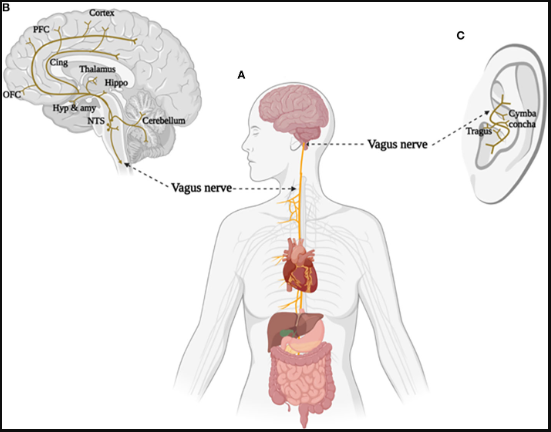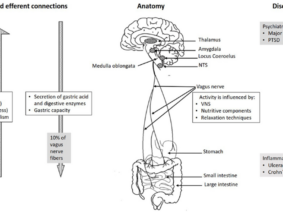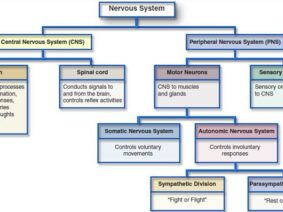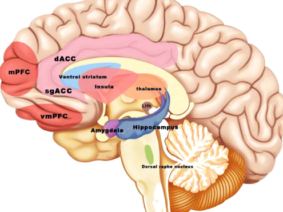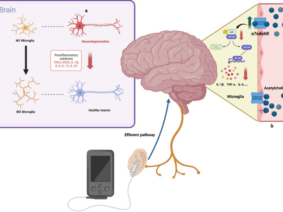Neuroscience Advancements and the Promise of taVNS
The field of neuroscience has witnessed remarkable progress, thanks to the advent of cutting-edge technologies. These innovations have ushered in a new era of treatment options, particularly in the realm of neuromodulation therapies. Among these, Transcutaneous Auricular Vagus Nerve Stimulation (taVNS) emerges as a standout neuromodulation technique. In contrast to the more invasive Vagus Nerve Stimulation (iVNS), taVNS offers several compelling advantages, including user-friendly operation, device accessibility, and fewer side effects.
Exploring taVNS: A User-Friendly Neuromodulation Method
TaVNS involves the stimulation of vagal afferent branches located in the outer ear, specifically at the cymba concha, utilizing an electrode. Its user-friendly design lends itself to a wide range of applications, and cranial imaging techniques validate its consistent impact on brain regions through ear stimulation.
Unlocking the Potential: taVNS in Cognitive Enhancement and Mood Regulation
TaVNS has demonstrated significant promise in enhancing high-order cognitive functions and regulating mood. Multiple studies have highlighted its effectiveness in cognitive control processes. For instance, research on associative memory and response selection has yielded favorable results. Moreover, taVNS consistently supports its role in emotion regulation and improved social functioning.
Expanding Therapeutic Applications: Addressing Pain, Fatigue, Anxiety, and Depression
Recent years have seen the diversification of taVNS applications into the therapeutic realm, targeting conditions such as pain, fatigue, anxiety, and depression. Vagus nerve stimulation activates the body’s regulatory systems, potentially dampening peripheral responses to inflammatory stress. It also exhibits analgesic effects by engaging with brain regions responsible for pain perception. This suggests the potential use of vagus nerve stimulation in the treatment of musculoskeletal and painful conditions.
Positive Outcomes in Visual Memory
Recent study findings unveiled substantial improvements in visual memory performance, particularly within the experimental group. Notable enhancements were observed in parameters such as the longest correct answer, the number of correct answers, and reaction time. However, no significant changes were observed in fatigue levels. When comparing the experimental and control groups, significant differences emerged in the longest correct answer and the number of correct answers, with no marked variations in reaction time and fatigue.
Scientific Foundations: How taVNS Impacts Brain Function
These findings resonate with previous research on the potential benefits of taVNS. Earlier studies have shown that taVNS can initiate the release of neurotransmitters and endorphins, contributing to enhanced brain plasticity and a balanced sympathovagal response. Furthermore, taVNS modulates the intricate interplay between the mind and body through the vagus nerve.
Cognitive Enhancement and Memory Boost
Regarding cognitive functions, taVNS has exhibited positive effects, particularly in improving memory performance among the elderly. However, some studies have reported mixed outcomes, suggesting that taVNS’s impact on cognitive functions might be task-dependent.
Exploring taVNS’s Impact on Fatigue
While taVNS has been explored as a potential tool for mitigating fatigue, research has yet to provide a definitive verdict. Some studies have indicated significant reductions in pain and fatigue, particularly in conditions like systemic lupus erythematosus. Additionally, taVNS has shown promise in improving sleep quality and alleviating conditions such as insomnia, fatigue, depression, and anxiety. Nonetheless, more research is required to ascertain taVNS’s precise influence on fatigue.
Concluding Thoughts and Future Directions
This study, despite its limitations like the recruitment of students from a single center and the application of taVNS for a limited number of sessions, suggests that taVNS holds considerable potential for enhancing visual memory performance. While its effectiveness in addressing fatigue remains less clear, it calls for further in-depth investigation. The evolving landscape of taVNS continues to present opportunities for therapeutic applications in various domains, emphasizing the need for ongoing exploration.
In conclusion, Transcutaneous Auricular Vagus Nerve Stimulation provides a promising avenue for improving cognitive functions, particularly visual memory performance. While its role in fatigue management requires further scrutiny, the evolving applications of taVNS underscore its therapeutic potential in diverse areas, necessitating continued exploration.
References:
